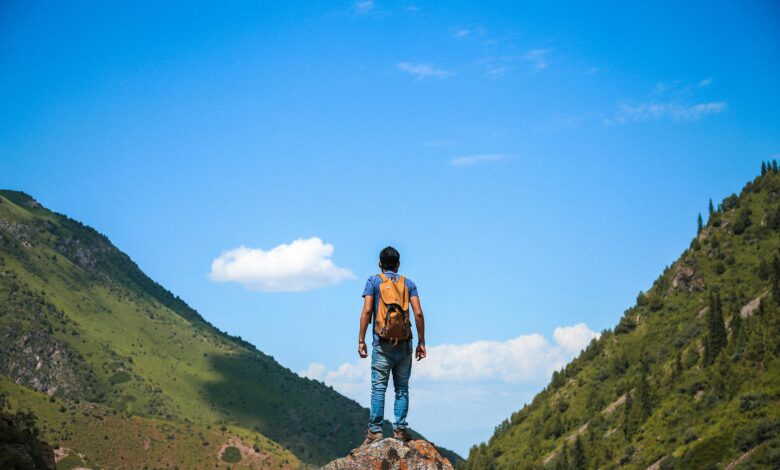Top 6 Considerations for EBC Trekking

The simplicity of well-maintained pathways combined with the breathtaking grandeur of the Himalayas can be experienced on the Everest Base Camp trip.
The Everest region, which is situated in the center of the magnificent Himalayas, is well known for its stunning scenery and hospitable Sherpa people. Along with exploring the world’s tallest peak, this journey offers an opportunity to learn about Nepali customs and culture.
Thousands of adventure seekers travel to one of the most well-known treks in the world every year. This trip takes place in the Khumbu region of Nepal and typically lasts 12 to 14 days. The trek’s longest stretch is around 130 kilometers, with Kala Patthar, 5,545 meters above sea level, acting as its peak.
You still need to take some things into account both before and during the expedition, even though it may seem exciting and daring. It is crucial to take these factors into account so you can enjoy a hassle-free, enjoyable, and safe hike.
We’ve outlined a few things to think about before and throughout your walk to ensure it’s safe and enjoyable.
Considerations Before or During Trekking
Even if trekking to Everest Base Camp seems like a lot of fun, there are still a few things to think about while ensuring your comfort and safety. Even though it takes a lot of trekking to get to Base Camp, the amazing sights and sense of accomplishment make the effort worthwhile. The following points should be remembered:
Weather
The entire experience and the trek’s safety are greatly impacted by the weather. The spring and fall, right before and right after the monsoon, are the greatest times of year to go trekking.
Bright skies and moderate temperatures are typical of the weather in March through May and September through November.
The weather should always be checked before packing because temperatures might drop significantly, especially at night. You may be shocked by how warm it gets during the day if it’s sunny. Even if the weather looks to be sunny, don’t forget to carry a raincoat.
However, climbing to higher heights is challenging during the severe, frigid winter months of December through February, which also raises the possibility of snow obscuring the paths. During the monsoon season (June to August), heavy rainfall makes the ground slick and unstable, which raises the risk of landslides.
Although reservations can also be made in the off-season, you should exercise extra caution in light of the weather and take all necessary safety precautions. Compared to other seasons like autumn and spring, the journey could be more challenging during the winter and monsoon seasons.
Temperature Ranges
Springtime temperatures range from 10 to 20 degrees Celsius (50 to 68 degrees Fahrenheit) at lower elevations. As you rise, the temperature gradually decreases, particularly at night.
Higher altitudes, like as Gorak Shep, the last stop before Everest Base Camp, can see daytime highs of -5 to 5 degrees Celsius and nightly lows of roughly -15 degrees Celsius (5 degrees Fahrenheit).
Autumn is a popular hiking season because of its bright skies and regular weather. Daytime temperatures at lower altitudes can be similar to springtime, ranging from 10 to 20 degrees Celsius (50 to 68 degrees Fahrenheit).
At higher elevations, daytime highs of 0 to 10 degrees Celsius (32 to 50 degrees Fahrenheit) and nighttime lows of -10 degrees Celsius (14 degrees Fahrenheit) or below are common.
Health And Fitness
To take on this difficult journey, you must be in good physical and training shape. Due to the high altitude, steep inclines, and rugged terrain, this climb requires a high level of physical fitness. It is recommended that you start your training at least two months before the intended adventure.
If you are ill, make sure to get a general health examination before the walk. In addition, you should monitor your hydration levels and food, particularly while on the hike. Make sure your day pack contains a enough amount of protein and energy bars, and take short pauses throughout your hike to snack on them.
It’s recommended that you consume carbs and protein-rich foods, such rice, lentils, and meat, for lunch or dinner at tea houses and lodges to help with muscle building and recovery. Before starting the walk each day, make sure you have a hearty and satisfying breakfast at your lodges. Eat light at night to aid in digestion and prevent altitude sickness.
Respect local sanitary norms and practices. Use potable water that has undergone purification with the help of tablets. Keep an eye on food hygiene to avoid digestive issues. Always remember that your security comes first. Be mindful of your health, follow safety procedures, and be prepared for the challenges that come with trekking at high elevations.
In case of Altitude Sickness
The hardest thing you’ll face on your trek is altitude sickness. Simple precautions against altitude sickness include staying away from all alcohol, staying properly hydrated, carrying energy bars, and eating snacks along the hike.
The most important thing to keep in mind is to hike at a leisurely pace, since there is no deadline for finishing this race. Therefore, ensure that your body adjusts to each evaporation. If you experience any symptoms, give yourself an extra day to adjust.
Budget
The most important thing to think about while planning a trip is your budget. The entire fee covers a number of expenses, including equipment, food, hotel, and permits.
All of the permits, lodging, and meals are included in the price if you reserve your Everest Base Camp trek package with us. Therefore, you can only take your personal expenses into account when you are trekking.
Travel expenses include flying to and from Lukla, the Everest area’s starting point, as well as potential fees for further flights in the event that the Lukla airfield is affected by severe weather. The type of lodging you choose will determine the cost; possibilities range from affordable teahouses to opulent hotels.
Meal costs also differ; higher altitudes result in higher costs due to transportation logistics challenges. Purchasing or renting trekking poles, warm clothing, and sleeping bags are among the equipment costs.
Even if everything may be leased in Kathmandu or Lukla, having personal equipment ensures comfort and familiarity. Unexpected expenses, such emergency medical fees, should also be included in a budget.
Make sure you have cash with you for the hike and try not to rely too much on ATMs. Only up to Namche Bazar are ATMs accessible, and even then, there is only one ATM per location. It is therefore recommended that you bring cash with you on your journey.
During the EBC Trek Generally speaking, a well-planned budget is required for a smooth trip. By finding a balance between budgetary considerations and the desire for a safe and enjoyable trip, one may guarantee a fantastic trekking experience in the Himalayas.
Equipment and Gear
Gear and equipment are the essentials you should think about before your trip. They assist you in making your journey safer in addition to becoming easier. Selecting the right tools and supplies is crucial to preparing for the hike.
Strong, properly fitting hiking boots are essential because they provide the support needed for uneven terrain. It is simpler to adapt to changing conditions while wearing warm, breathable clothing layered underneath, and a high-quality waterproof jacket is essential for protection against erratic mountain weather.
In addition, UV-protective glasses and sunscreen with a high SPF are essential for avoiding the intense mountain sun. Wearing a wide-brimmed cap with a beanie protects against the sun and cold. To make sure you have access to clean drinking water throughout the route, don’t forget to bring along a water bottle and purification tablets.
In Kathmandu or Lukla, certain equipment can even be rented. The presence of your equipment, particularly well-worn boots and a comfortable backpack, significantly impacts how much you enjoy trekking.
You can ensure you have everything you need and focus on the breathtaking surroundings and many cultures seen on the base camp excursion by making a detailed itinerary and getting started early.
Permits
The paperwork that grants you permission to enter Sagarmatha National Park is called a permit. Obtaining the necessary permits is a crucial step in preparing for the Everest Base Camp expedition. The two primary permissions that are needed are the Sagarmatha National Park entry permit and the Trekkers’ Information Management System (TIMS) card.
The Sagarmatha National Park, which includes the Everest region, requires access permits. You can obtain this authorization at Kathmandu, Monjo, or the national park entry. There is an additional permission fee for foreign hikers, which is roughly $300 USD. A current picture ID must be brought with the permit in order to complete it.
To ensure the security and well-being of hikers in the region, the Trekking Information Management System (TIMS) card is an extra necessary document. It includes details about the trekkers’ personal traits and routes. To obtain a TIMS card, visit the Nepal Tourism Board in either Pokhara or Kathmandu.
It is advisable to check the most recent permission requirements and expenses before embarking on the expedition, since they may have changed. Having these permissions in order not only ensures compliance with local laws, but it also helps the amazing Sagarmatha National Park with its conservation efforts.
Travel Insurance
Trekking necessitates weather adaptation for the sometimes harsh conditions found in the highlands. There might be times when you injure yourself. One may sustain injuries from a fall, sprain an arm, or have altitude sickness.
Furthermore, even for the most basic diseases, you can have to pay exorbitant amounts to receive medical assistance for your illnesses in the remote highlands. In addition, if you have to use a helicopter to evacuate yourself, your trip expenses can go double or perhaps quadruple.
Moreover, you cannot ignore the several modes in which you could encounter difficulties. These consist of petty thefts, luggage damage, and postponed travel. For the trek, you ought to purchase travel insurance because a lot might go wrong on a poor day.
Your travel insurance may be necessary in a number of circumstances, including altitude sickness, accidents, aircraft cancellations, and other illnesses. Therefore, it is strongly advised to purchase travel insurance simply to be safe.
When you travel overseas, you will always be pushing yourself beyond your comfort zone. There are going to be new people you meet and places you have never been. Although Nepal is a rather safe country for travelers of all genders, you can’t always guarantee that your belongings or well-being won’t be compromised.
But getting insurance might ease your mind regarding the safety of your possessions. Securing insurance and putting your problems behind you will result in a vacation free from tension.
Achieving Success Through Preparedness
Finally, the expedition requires training on both a mental and physical level. At least two months prior to the trip, training should start, with an emphasis on gradually increasing aerobic and strength-training activities.
Stretching exercises and hiking can assist improve endurance and flexibility while reducing the risk of injury. A healthy, well-balanced supper can help the body get ready for the hike.
Mental preparation can include learning about the subject, doing research, adopting a positive mindset, and practicing relaxation techniques.
By allowing ample time for preparation, avoiding weariness, and placing rest and water at the top of your priority list, you may help ensure a safe and enjoyable trekking experience to Everest Base Camp.


